How Does Trailer Construction Affect Towing Performance?
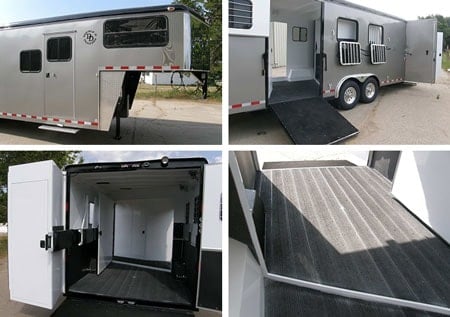
Big, small, welded, non-welded, basic, or fully equipped. They can be built from steel, z-frame, aluminum, or some hybrid combination in between. Then, the shape of the trailer can vary from slant load to straight load, v-nose to flat face, with other outrageous shapes and designs thrown in for fun.
So, did you ever think of how your trailer’s construction affects your towing performance? Well, it does! In this article, we’re going to dive into some examples of how seven factors make a big difference on the road.
Factor #1: Weight Distribution
People who are hauling non-living loads have it easy when it comes to weight distribution. They can simply stack their cargo neatly in rows, so it is evenly balanced side to side and front to back over the trailer axles.
Think of a moving truck filled with furniture or a delivery truck stacked with neat boxes of product. The load is well-secured, well-balanced, and it’s concentrated near ground level.
Easy peasy!
Live animals, on the other hand, make things much more difficult.
Horse trailer’s need to account for varying numbers of horses and equipment on any given day. Sure, you own a four horse trailer designed for warmbloods, but today you really only need to haul your Shetland to the local fair for pony rides.
Plus, the loads in horse trailers are much higher off the ground (well, unless we’re still talking about the Shetland.) With full-sized horses, we’re talking about a thousand pounds balanced on four legs with an animal brain in control.
And speaking of that animal brain. Horses move! You’ve probably felt your animals adjusting their balance around turns or stomping feet in frustration when you’ve forgotten to give them enough hay for the trip.
Here at Double D Trailers, we take a hard look at all of these variables when designing our trailers. We position the trailer axles in such a manner that the trailer will still be safe regardless of your day’s horse and cargo load.
For some trailers, too much weight towards the front can create a situation called “dive.” This happens when the rig dips at the center and pushes the front wheels of your vehicle slightly off the ground. It’s not going to be super obvious (unless it’s really severe), but too much dive can make steering with your front wheels difficult.
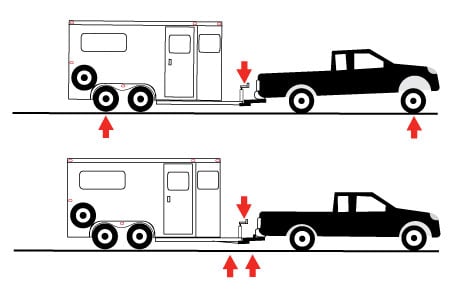
Together, these components provide additional hitch points between your tow vehicle and trailer. It helps transfer load more evenly among the axles on your truck and trailer combo.
As a result, you’ll have improved steering and braking while driving. It also makes things more comfortable for your horse since the trailer is sitting with better ‘attitude’… aka more level to the ground.
Since we're on the topic, let’s take this opportunity to look at one trailer design that fails the load distribution test in a big way…
We’re talking about bumper pull horse trailer with living quarters.
Thinking in terms of load distribution, imagine a 2 horse living quarters bumper pull trailer with all of its weight towards the front of the trailer. The weight of the trailer pushes down very heavily on the rear of your tow vehicle and likely causes reduced steering with the front wheels.
In addition, many living quarter bumper pull trailers are so heavy in the front they exceed the tongue weight rating on the tow vehicle’s hitch. This situation is very dangerous and is at risk for hitch failure down the line.
We definitely do NOT recommend bumper pull living quarters trailers that are designed for more than a single horse. If you really want a bumper pull with living quarters, check out this much safer single horse trailer version.
Factor #2: Hitch Design
As you know, trailers come with either bumper pull or gooseneck hitch design. One of the most important things you can do when you buy your new trailer is double check that your tow vehicle is well-suited to your trailer.
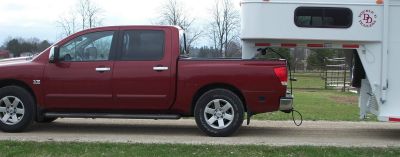
If you’re interested in a gooseneck trailer, make sure your gooseneck hitch is placed in the correct position within your tow vehicle. You may be pleased to learn that gooseneck trailers are often easier to haul at highway speeds since the wind provides less resistance and causes less wobble than with bumper pull trailers.
Factor #3: Trailer Length
Now, let’s take a look at trailer length. Yes, a very long trailer is going to be a bit more challenging to haul. You’ll need to take very wide turns and possibly need a second set of eyes when maneuvering into a parking area.
This is one of the reasons why we highly recommend a slant load horse trailer. Slant load trailers, like our patented reverse SafeTack trailer, make much better use of the floor space. This results in a shorter trailer front to back with all of the features you need still included.
Factor #4: Tires
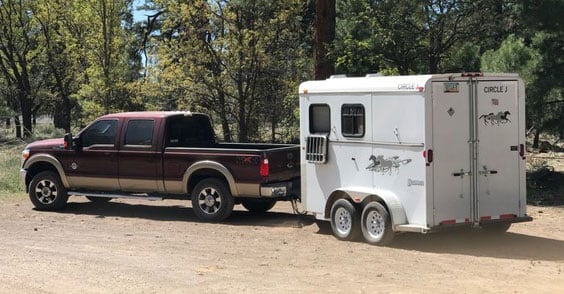
Later on, you’ll need to take into consideration the Gross Vehicle Weight Rating (GVWR) -- that describes the total amount of weight a trailer is designed to handle. If you take this amount and divide it by the number of tires, you’ll know how much weight each new tire needs to be designed to carry.
We recommend “ST” tires rather than “LT” tires and always caution customers not to buy tires rated for overly heavy loads. When these ‘overkill’ tires are used, it puts excess strain on the trailer’s axles and brakes, strains your hitch, and causes a very bumpy ride for your horses.
We had one customer who absolutely insisted on overly stiff tires for her trailer. Once she realized how rough the ride was (and how angry her horses were), she quickly called us up to admit her mistake. We switched out for more appropriate tires and everyone was happy… especially the horses!
Find our tire brand and inflation recommendations here. Then, read about ways to properly maintain tires while a trailer is in storage. Tires that spend long months in the hot sun may age out before they wear out. They become dry and brittle with a greater risk of blow out.
Factor #5: Wind Resistance
We’ve already mentioned briefly how wind can play a factor when towing a gooseneck trailer versus a bumper pull trailer. In general, you want your trailer to be as stream-lined as possible. At Double D Trailers, we accomplish this by adding a V-nose feature to many of our designs.
Besides reducing wind resistance on the highway, this design serves another important purpose. Sometimes, with a flat faced gooseneck trailer, a very tight turn will bring the front corner of your trailer in contact with your pick-up truck’s back windows. It’s even possible to break the glass!
When making very sharp turns with a gooseneck trailer, the V-nose eliminates risk of rear window blow out.
Factor #6: Welding
Back in the day, the only way to attach a piece of horse trailer skin to the metal frame was by welding. Unfortunately, on steel trailers, there is no way to completely seal off this joint so moisture is able to seep its way in. Eventually rust forms and the entire structure weakens.
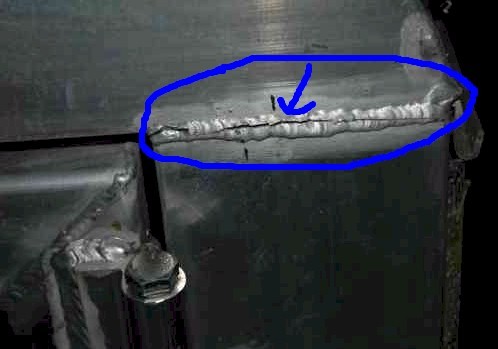
Today, methods to secure one type of metal to another metal are much more sophisticated than they were 30 years ago. We’ve developed new paints, sealants, compounds, primers and technologies like 3M chemical bonding.
It is now possible to secure a trailer’s skin without the use of bolts, screws, or rivets that are vulnerable to weathering. This results in a longer lasting trailer and a much quieter ride for your horse. (All of those metal-on-metal connections make noise when you’re on the road!)
Factor #7: Building Materials & Weight Ratio
And finally, let’s take a moment to talk about building materials. Here at Double D Trailers, we talk about building materials until we’re blue in the face... and for good reason! The right building materials for your trailer can result in a much safer and more comfortable ride for your horse.
Specifically for towing, it’s important to consider your horse trailer to tow vehicle “weight ratio.” Make sure the weight of your horse trailer is around double the weight of the horses being transported. Then, your tow vehicle should weight close to the combined weight of your trailer and horses. We just wrote a detailed article on this topic, so check it out!
If you have any questions about how trailer construction affects towing performance, reach out to Brad Heath for help. Happy towing!

